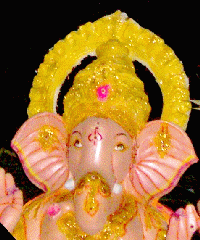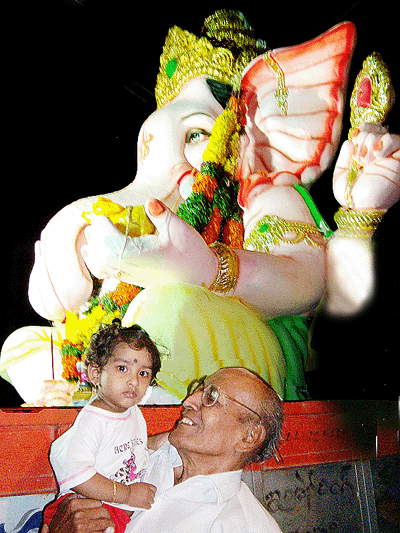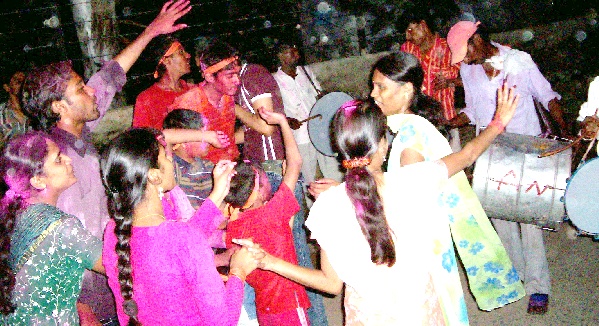 The Ganesh festival celebrated all over India falls roughly between mid-August and mid September according to the lunar calendar. It is one of the most popular festivals.
The Ganesh festival celebrated all over India falls roughly between mid-August and mid September according to the lunar calendar. It is one of the most popular festivals.  The Ganesh festival celebrated all over India falls roughly between mid-August and mid September according to the lunar calendar. It is one of the most popular festivals.
The Ganesh festival celebrated all over India falls roughly between mid-August and mid September according to the lunar calendar. It is one of the most popular festivals.
Ganesh is a deity with the head of an elephant. Actually, according to the very ancient legend, he didnt have originally an elephant head--it was surgically attached after some interesting events.
Large numbers of people in India are very attached to the deity Ganesh. It seems to hark back to times when forests covered most of the land and people organised themselves into tribes. Over the years the stories, legends, observances and so on have collected around an elephant headed deity. Here's some of the popular ones.
The elephant headed deity
Ganesh, also called Ganapati (gun-ah-putty), Vinayak, has the head of an elephant, and is as strong as one, and is the son of the mother goddess Paarvati (paahr-vatti). He acquired as his father later, the ancient pagan deity Shiva. Ganapati means leader of the ganas, people in the general sense and the soldiers of Shiva in this context.
Having the nature of a heavy elephant, he is either an obstacle, or assists in removing obstacles if requested politely. In India, new ventures are usually started off by ritually remembering and invoking Ganapati. He has a terrific memory and is the patron deity of scribes and anything connected with learning and wisdom.
"Gods" in India are legendary powerful persons, something similar to saints in catholic notions, and they have interesting stories and legends about them. Usually, the deity is actually an ancient tribal identity and in several cases the rituals and observances are not so much "religious or pious" but have a very sensible reason connected to the agricultural calendar.
Remember people couldn't go to schools and colleges in tribal times : few were literate: there were no books or music or TV. Story telling, singing, dancing and "religious" observances were the media of instruction. Once we understand this, lot of things become clear.
How Ganapati got the head of an elephant
Ganapati didn't originally have an elephant head. Interesting story which goes deep into the primeval past . According to the story Parvati, wife of Shiva was having a bath and told the sentry not to allow anyone inside. But Shiva came to the door and was let in by the gatekeeper. Parvati was embarassed: she felt these were after all Shiva's people and attendants, not really her own who would follow her instructions. So she felt she ought to have at least one who was her own. So when she had her bath, she created one from the shampoo (--herbal, of course) and foam by rubbing her skin. The boy had all the good qualities and what was more, obeyed no one but Parvati. Shiva was away on some work while Ganesh was told to guard the door.
Shiva turned up with his followers. As Shiva tried to walk in, Ganesh stopped him. Initially Shiva was amused--one of my soldiers on guard duty who doesn't know me, good fellow, all right now get out of the way. But Ganesh refused to budge. His mother had told him to allow nobody, but nobody in and that was that. Initially Shiva didn't want to get into a fracas with a small gana, so he asked his followers to get him out of the way. But in the scuffle which followed, Ganesh easily hammered all of them with a stout stick. Even the powerful leaders were soundly thrashed, much to their astonishment.
Finally Shiva came up but he too was severely beaten by the little gana. Then he lost his temper, irritated at not being allowed into after all, what was his own home. So in a fit of rage, he cut off Ganesh's head. Just then Parvati came out.
When she saw what had happened, SHE lost her temper. Now even Shiva, lord of the worlds and animals, sometimes gulps when his wife lets fly. After all she is nature personified. As she raged and roared and shook in anger, untold numbers of calamities took place in the universe. Echoing her anger, immense stars began to explode dutifully all over the universe. Planets wobbled off their orbits. Volcanoes erupted, the earth quaked, oceans crashed far inland and the mountains started flying again. Wholesale destruction began, the "pralaya" (dissolution of universe) which was supposed to happen after many, many eons started much ahead of schedule. Even the various heavenly beings occupying high positions found their thrones teetering. So they all rushed to calm her down. Shiva realising his error, very much regretted he had destroyed such a fine boy, his own wife's creation, and who was after all only following orders steadfastly. He promised any number of Ganas to replace the one he destroyed: but Parvati was still furious.
Finally the divinities asked Brahma, who is in charge of all creation, to see what he could do. "His head has been cut off : he needs a head : bring me the head of the first being you find in this direction," he said. So they set off in a hurry---Parvati was getting even angrier--they found a dead elephant. So Brahma fitted the elephant head and Ganesh woke up. Since then Ganesh, the creation of Parvati, bears the head of an elephant. Shiva who is easily pleased, smiled and welcomed him back and gave him several gifts. Parvati cooled down soon enough, the planets settled back into their appointed courses, the Earth became peaceful again. The Gods and others wiped their brows and went away in relief. Now the family came together happily. Parents and their son. The ganas sang and danced in celebration, and Ganesh was appointed as leader of the Ganas, "gana -pati".
The Ganas
The Gana are the followers of Shiva. They number in millions. They are all very poor and have hardly any possessions, like their leader Shiva. According to the legends, they are usually dwarfish, comical, mis shapen, grotesque, peculiar looking, goblins, ( maybe something like trolls and elves) . They look strange and wear peculiar costumes and so forth. They are strongly attached to Shiva and are always ready to do his bidding. They function as the army of shiva, if need arises.
On one occasion they attacked Daksha's ritual hall too. Daksha did not invite Shiva for a grand vedic sacrifice, whilel all the other gods etc were called. Now Daksha was actually Shiva's first father in law, but he insulted Shiva for what we might consider his meager bank balance. Shiva wasn't bothered about it, but his wife (daksha's daughter ) couldn't bear it and burst into flames. Shiva then got furious and resolved to fix Daksha. The enraged followers of Shiva, the Ganas came in a huge swoop, fell upon the hall, beat up the participants, the Gods and other divinities and kicked the high personages who had assembled , vandalised and finally burnt up the hall of the vedic aryan ritual sacrifice of Daksha. ...he then mended his ways.
There are many legends of Ganesh. As his character is that of an elephant, he likes to eat huge amounts of food. But only vegetarian stuff, like elephants. He is also very fond of sweets. After eating he likes to dance. (heavy as he may be). So during the festival of Ganesh there's a lot of food and music.
According to another legend, Indian gods need vehicles to travel. Sarasvati the deity of learning and wisdom has a swan: Shiva prefers to ride on the back of a bull : Vishnu an eagle: Brahma a goose: but Ganapati chose, of all things, a mouse.
 So he is depicted with an elephant head and elephant sized body sitting on top of a small mouse. Mice can go anywhere, as we know.
So he is depicted with an elephant head and elephant sized body sitting on top of a small mouse. Mice can go anywhere, as we know.
Apart from the humour, it seems several tribes with different totems and sacred animals merged together over the thousands of years, instead of massacring one another.
The whole of India was covered with thick forests: thousands of species of wild animals roamed free. To the ancient Indians ( paleolithic tribals), the fact an elephant or mammoth had a trunk, almost a hand, must have been striking. In later times, several ancient dynasties used to style themselves as elephants or lords of elephants. The Satavahana imperial emblem of chioce was an elephant. Even the Harappan seals picture the elephant most naturalistically. The Ganesh festival is basically an observance of the tribal and so called low caste people and farmers and has been taken over by the upper crust as well over the centuries.
In the earliest Hindu books, however, Ganesh is not yet a benevolent deity, actually a fearsome obstacle. Elephants are good obstacles, as anyone can imagine. Later the obstacle to farmers and travellers became the remover of obstacles. Elephants also are associated with good luck and auspiciousness, so gradually the rites of calming and handling elephants and elephant deities became crystalised into regular worship and services in small temples. Little carvings of an elephant headed deity are found in ruins of very old temples.
The celebrations
The worship/rituals/services connected to Ganesh were essentially small family affairs until the last century. During the British period, all forms of political activity were closely monitored. Group activity was frowned on, and large scale activity was simply banned. The British however treated religious gatherings with a greater degree of freedom, not so much from a liberal spirit as a pragmatic one. (these could easily be pushed into communal channels, creating disunity and assuring the continued British rule.) It was Bal Gangadhar Tilak who sensed an opportunity. Taking a cue from calcutta religious processions, he organised in Bombay ( mumbai) the Saarvajaanik Ganesh Utsav. ( ganesh festival open to all castes and creeds). He was among the first to organise textile labour unions, by the way. This way thousands of people could assemble in an ostensibly ancient religious function. But once the crowds gathered the British couldn't intervene and helplessly watched the crowd roar and cheer the anti imperialist, liberty and freedom! slogans and speeches. Thus this 'open to all' festival spread all over India. In the days before independence, several far sighted people recognised the social character of the festival and participated in it-- regardless of the religion they professed. Even today christians and Muslims take part too. ( in spite of attempts to communalise the festival exactly like the British did. )
 Apart from the religious observances it is a time of good cheer and goodwill for fellowmen in a common endeavour. The tradition, of an ancient origin, is renewed and maintained: it is common to see groups of grandparents with their grandchildren at the festival, sharing remniscenes of festivals of their childhood.
Apart from the religious observances it is a time of good cheer and goodwill for fellowmen in a common endeavour. The tradition, of an ancient origin, is renewed and maintained: it is common to see groups of grandparents with their grandchildren at the festival, sharing remniscenes of festivals of their childhood.
In some places it has become a platform to make a point: to demonstrate huge Hindu numbers and strength like in Hyderabad.( this is an obviously a common man's reaction to bad treatment under previous rule, but also very useful for games of politicians' --all politicians.) In Pune, maharashtra it has even become a tourist event. In places like Mumbai the festival is celebrated on a huge scale.
The preparations for the event start six months earlier. Apart from the painted clay statues for the parades, the temples have to be cleaned up, cultural progammes have to be planned, scripts written, dances choreographed, music composed, etc etc. Funds are collected from local residents and businesses: usually city wards and localities and large industries have their temporary stages where a statue of Ganesh is installed, services are done during the daytime, and in the evenings there are cultural functions. Families dress up in their new clothes and visit the various large Ganesh installations and the cultural programmes. There is usually a healthy rivalry between organisers of the various Ganesh "pandals" or decorated stages.
The high point, of course, is the mammoth parade( pardon the pun). There is a notion in India that all things must pass through their natural cycle: so clay idols and statues also should not be stored away after use, nor should they be neglected and allowed to crumble to pieces. Ideally, these should be consigned to the waters where the clay dissolves back to the original elements. So after the services and poojas and programmes are over, there is a chaotic singing and dancing parade all the way upto the banks of the nearest body of water, the ocean, a river, a lake, a pond, even a little village well.
Modern aspects of Ganesh festival

Today, though, the prehistoric tribal festival has come a long way and become a religious and socio-cultural event.
The Ganeshas are becoming bigger and bigger and decorated with electronic lights and gaudy colours. In Mumbai the film crowd's skilled set builders use their ingenuity to create fancy Ganeshas. In recent times contemporary themes of the year are being woven into the display, like launching of satellites and the like. I recall a Ganapati seated on a rocket or something. And one in a silvery space suit too: a Ganesh siting on a pile of lottery tickets, a hi tech ganapati, a Ganapati armed with a laser, a robotic ganapati etc. Then there was a "disco" or "rock" ganapati. ( When criticised the organisers said Ganapati is said to love dancing to music, but nowhere in the scriptures was it specified what type of music. All Ganapati wanted was the music should be lively. The traditionalist critics quietened down, said Oh! in that case, its OK). Then, in the old books young Ganesh slips and falls because he was in a hurry. ( the idea is to tell kids ---dont be hasty, slow and steady wins the race, etc) So someone came up with a design of a slipping Ganesh. There are also contests between various organisers. Professional folk and classical dancers and gymnasts get a chance to show off their dazzling talents in the processions.
One youth activity which has become popular is a combination of other festivals like Holi and Krishnashtami : a coconut is tied to a rope and suspended from a high crossbar: the participant has to try and smash it with a stick, while the rope is pulled up at random intervals, and all the while others splash buckets of water at him. Not easy, ruins the aim.
Everybody in India seems to like elephants. These stories go back to a time when there were no buildings, no computers, no cars, no machines....just forests. And elephants.

© V Ramchandra Rao ..all rights reserved.
updated sept 2008
email : vramrao@yahoo